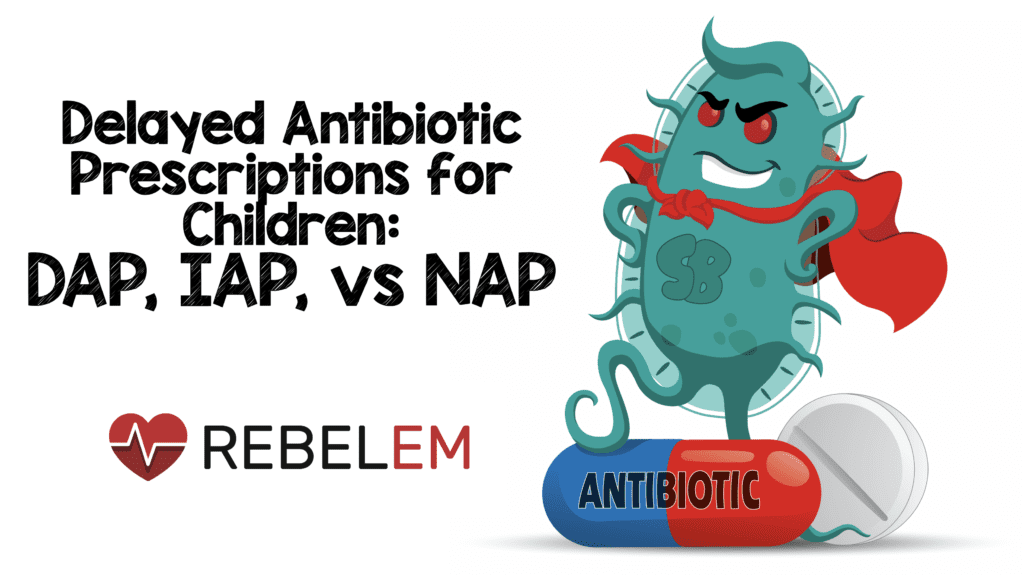
Paper: Mas-Dalmau G et al. Delayed Antibiotic Prescription for Children with Respiratory Infections: A Randomized Trial. Pediatrics 2021. PMID: 33574163
Clinical Question: What is the effectiveness and safety of delayed antibiotic prescription (DAP) vs immediate antibiotic prescription (IAP) vs no antibiotic prescription (NAP) in children with uncomplicated respiratory infections?
What They Did:
- Multicenter, randomized clinical trial comparing 3 antibiotic prescription strategies in children with acute uncomplicated RTIs from 39 primary care centers in Spain
- Children randomly assigned to:
- Delayed Antibiotic Prescription (DAP)
- Prescription given to parents and recommended to only consider administering antibiotic if
- Child did not start to feel better after 4, 7, 15, 20d from symptom onset for acute otitis media, pharyngitis, rhinosinusitis, or acute bronchitis, respectively
- Child had a temperature of ≥39C after 24hrs or a temperature of ≥38C but <39C after 48hrs
- Child felt much worse
- Immediate Antibiotic Prescription (IAP)
- Prescribed antibiotics to be taken from the day of consultation
- No Antibiotic Prescription (NAP)
- No antibiotics prescribed
- Prescription given to parents and recommended to only consider administering antibiotic if
- Delayed Antibiotic Prescription (DAP)
Outcomes:
- Primary: Symptom duration and severity over 30d
- Symptom severity scored by parents on a 7-point Likert scale
- 0 = absence of symptoms
- 1 to 2 = mild symptoms
- 3 to 4 = moderate symptoms
- 5 to 6 = severe symptoms
- Symptom severity scored by parents on a 7-point Likert scale
- Secondary:
- Antibiotic use over 30d
- Parental satisfaction scored on a 6-point Likert scale
- Extremely satisfied to not at all satisfied
- Parental beliefs scored on a 6-point Likert scale
- Extremely effective to not all effective
- Additional primary care visits
- Complications at 30d (i.e pneumonia, abscesses, cellulitis, visits to the ED, and hospital admissions)
Inclusion:
- Age 2 to 14 years
- Attending a primary care pediatrician’s office
- With the following conditions:
- Pharyngitis
- Rhinosinusitis
- Acute bronchitis
- Acute otitis media
- Pediatrician had reasonable doubts about the need to prescribe an antibiotic
Exclusion: Not stated
Results:
- 436 children included in the analysis
- 88.3% of children were in the age range of 2 to 10 years
- 51.4% of visits were for acute otitis media
- 33.5% of visits were for acute pharyngitis
- Most frequent symptoms were fever and/or general pain
- Mean duration of symptoms at first visit was 2.5d
- Mean Duration of Severe Symptoms:
- DAP: 12.4
- IAP: 10.1
- NAP: 10.9
- P = 0.539
- NOT STATISTICALLY SIGNIFICANT
- Median Greatest Severity for Any Symptom:
- DAP: 3
- IAP: 3
- NAP: 3
- P = 0.619
- NOT STATISTICALLY SIGNIFICANT
- Antibiotic Use:
- DAP: 25.3%
- IAP: 96%
- NAP: 12.0%
- P < 0.001
- Complications, additional visits to primary care, and satisfaction were similar for all strategies
- No difference in the antibiotic treatment duration nor the type of antibiotic for the 3 arms
- GI adverse effects were higher for IAP
Strengths:
- Largest randomized clinical trial on DAP for children
- First study of DAP in pediatric population in a European country
- Both the severity and satisfaction scales have been previously validated and used in other trials
- Used an intention to treat analysis which included all patients randomized and most likely follows real world practice
Limitations:
- Children, parents, and health professionals were not blinded
- Convenience sample of patients. It’s hard to believe that 39 primary care centers over 4 yers could only recruit 436 patients
- Only included patients if pediatrician had a reasonable doubt that antibiotics should be given. This could be one of the many reasons why so many patients were not recruited
- Trial slightly undrpowered as the goal was to recruit 450 patients
- No exclusion criteria listed
- Children followed up via phone call and not in person
- Low prevalence of rhinosinusitis and acute bronchitis in this cohort
Discussion:
- Parents were told regardless of arm and counting days from the onset of symptoms, children were likely to feel more or less the same for up to:
- 4d for acute otitis media
- 7d for pharyngitis
- 15d for rhinosinusitis
- 20d for acute bronchitis
- Authors were looking for a 2d reduction in duration of symptoms
- The authors essentially took a bunch of diagnoses, we know are mostly viral and found no benefit for antibiotics
Author Conclusion: “There was no statistically significant difference in symptom duration or severity in children with uncomplicated respiratory infections who received DAP compared to NAP or IAP strategies; however, DAP reduced antibiotic use and gastrointestinal adverse effects.”
Clinical Take Home Point: Although the authors state there is no statistically significant difference in symptom duration or severity in children with uncomplicated respiratory infections who received DAP compared to NAP or IAP strategies, it seems to me the NAP strategy was the clear winner. Less antibiotics taken compared to DAP or IAP, in patients with diagnoses that are known to be mostly viral, with no difference in duration of symptoms, severity of symptoms, or complications.
References:
- Mas-Dalmau G et al. Delayed Antibiotic Prescription for Children with Respiratory Infections: A Randomized Trial. Pediatrics 2021. PMID: 33574163
Post Peer Reviewed By: Anand Swaminathan, MD (Twitter: @EMSwami)



